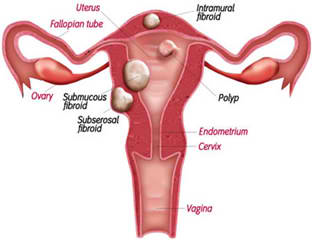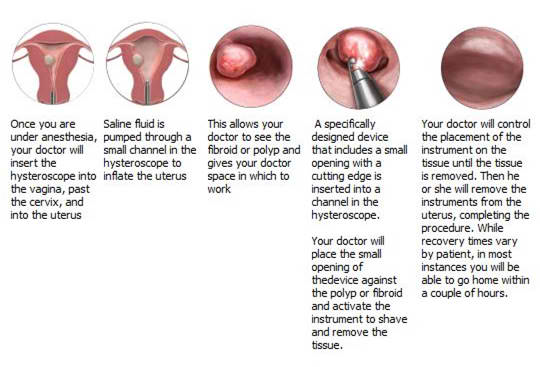 |
 |
The causes of abnormal uterine bleeding (prolonged or excessive bleeding, as well as bleeding between periods) vary and commonly include endometrial polyps or uterine fibroids. Endometrial polyps are growths extending from the lining of the inside cavity of the uterus. Polyps can also cause spotting in menopause and in rare cases become cancerous, usually in women over the age of 50. Uterine fibroids (also called myomas or leiomyomas) arise from the muscular wall of the uterus. They vary in size, number, and location. It is estimated that 25% to 50% of women between ages 30 to 50 have fibroids. Fibroids are not typically associated with an increased risk of uterine cancer and almost never develop into cancer. Only fibroids that cause symptoms need to be treated.
You don’t have to let abnormal bleeding interfere with your daily activities. While there is no medication to treat polyps and fibroids, there are procedures to remove them. If there are numerous fibroids, large ones, or they are located in the middle or outer portion of the wall of the uterus then either myomectomy (removal of just the fibroids), or hysterectomy (removal of the uterus) is necessary.
However, if these growths project into the uterine cavity then they may be removed with a hysteroscope (the insertion of a small scope through the cervical opening into the uterine cavity). Dilation & Curettage (better known as a D&C) has been shown to miss removal of lesions. Hysteroscopy is the preferred method as it allows visualization and targeted removal: via grasper for small polyps, hot-wire cutting resection loop or morcellation for fibroids. Morcellation uses an instrument inserted through the hysteroscope that rapidly shaves away growths. Since the system does not use heat it minimizes damage to the inner lining of the uterus, which helps preserve the chances of pregnancy in the future. This device also shortens operative time and enhances safety.

Hysteroscopic procedures are performed on an outpatient basis. If you have completed your family then your doctor may give you the option of also having an Endometrial Ablation to further reduce or eliminate your menstrual bleeding. Your doctor will provide specific details regarding postoperative care, but here are basic instructions:
1. You may have bleeding and menstrual-like cramps after the procedure. If so, use pads, not tampons. Heavy bleeding, which is rare, should be reported to your doctor. Ibuprofen or naproxen help relieve cramps.
2. Refrain from sexual intercourse or placing anything into you vagina (including tampons, douches, medication) for 2 weeks after the procedure.
3. You may return to work and light activities a day or two after your procedure. Vigorous activities and exercise may be resumed in one week.
4. Schedule a follow-up appointment 7-14 days after the procedure to discuss the results of your surgery.
This is another example of how Dr. Scott Kramer continues to be leader in advancing minimally invasive surgical techniques for women of the San Francisco Bay Area.








